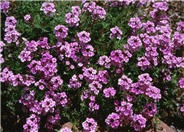
Common name:Trailing Lantana
Botanical name:Lantana montevidensis
Lavender flowers accent the trailing growth habit of this Lantana. It is excellent for spilling over walls or down banks. Eventually, it will reach about 2' tall by 6' wide; size is controlled by pruning and severity of winter. It does best in full sun and is drought tolerant. It grows rapidly, even in heat, smog and poor soil. It is cold hardy to 25 degrees F, but recovers quickly. Fruit is poisonous. Butterflies are attracted to Lantana.

Common name:Azure or Russian Sage
Botanical name:Perovskia X atriplicifolia
This broad perennial will grow 3'-6' tall and has small, gray green leaves with blue violet flowers that bloom in the summer.

Common name:Verbena
Botanical name:Verbena peruviana
This perennial forms a flat mat that covers an area rapidly. It has dark green leaves with clusters of bright flowers that bloom all year. Hybrids will have a little more height, different flower colors and spread more slowly. It is drought tolerant.

Common name:Golden Barrel Cactus
Botanical name:Echinocactus grusonii
Golden Barrel Cactus has a globe shaped trunk and vertical ribs lined with thick rows of golden spines. It grows slowly to 3' tall. It looks handsome in containers. It can thrive in full sun but prefers some shade in low desert. This cactus prefers well drained soil and rots with poor drainage.

Common name:Trailing Germander
Botanical name:Teucrium X lucidrys
This mini-shrub with small, shiny, dark green leaves on woody stems can be sheared and shaped. The stems trail and rise to 24", with lovely, reddish purple flowers between the upper leaves. It can be used as a low hedge plant in herbal knot gardens. To encourage branching, it should be pruned in the spring. -Holland WIldflower Farm
| Designer: Joe Varonin ASLA | Seating and Tile Detail |
Photographer: Nancy Warfel |
Soils and Compost:
Incorporate compost 6" into your soil to retain water, reduce compaction, feed earthworms, and provide valuable nutrients to your plants.
Water Saving Tip:
Apply a layer of mulch around plants to reduce moisture loss.
Choose organic mulches, such as shredded bark, compost or aged sawdust.
Integrated Pest Management:
Remove irrigation water and fertilizer from areas where you don't want weeds to grow.
